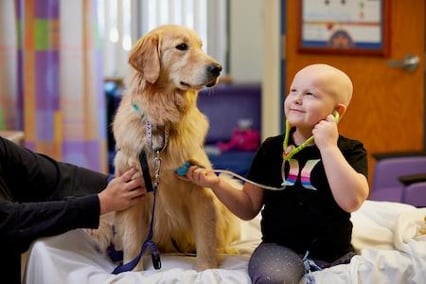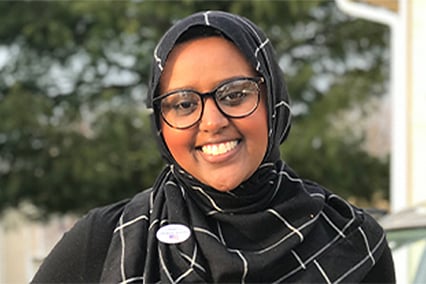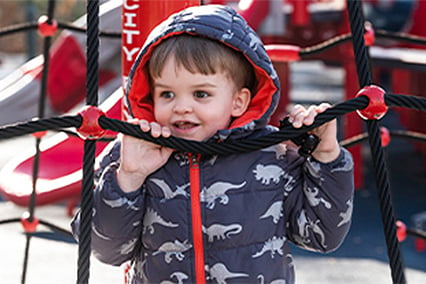Cellular Congenital Mesoblastic Nephroma: Chase's Story
Meet Chase

“Hey mom! You know what 3 + 5 is?” asks inquisitive 6-year-old Chase Jackman.
“No Chase. What is it?” responds his mom, La Daya Gordon.
“It’s 8!” Chase answers.
“Chase loves to count!” La Daya says, smiling. “And he loves to play games. Connect 4. Jenga. PlayStation. He’s a goofy, fun-loving kid who gives me like 1,000 hugs a day.”
But at just 7 months old, La Daya wasn’t sure her baby would live long enough to give her those hugs, or learn to count, or play any games. He was gravely ill, but no one knew it until La Daya noticed his belly looked like it was growing larger and larger.
“I didn’t know what was going on, so I took Chase to the Emergency Department at the Children’s Mercy Adele Hall Campus. He had been constipated, so I thought that might have something to do with it,” she said.
Doctors weren’t sure what was going on either.
“Initially, Chase was seen in the emergency room and was found to have signs of respiratory distress and lymphangioma, a benign lymphatic growth,” explained Lindsey Fricke, RN, MSN, FNP-BC, Nurse Practitioner.
Several days later, La Daya brought Chase back to the emergency room. His belly was even larger, and he was sicker.
“Chase wasn’t a very big baby, but he looked like he had a basketball in his belly,” La Daya said.
Additional imaging confirmed findings consistent with lymphangioma, and Chase was admitted to the pediatric intensive care unit (PICU) to begin treatment with sclerotherapy and medications.
While there, Chase developed a serious condition called abdominal compartment syndrome, and doctors operated, opening his abdomen to release the pressure building up inside, and leaving his abdomen open to heal.
“That day, doctors gave Chase 72 hours to live,” La Daya said. “We probably had 100 family members come to the hospital to support Chase through surgery. We took over the entire waiting room.”
Though Chase survived the surgery, he was intubated and in the PICU on a ventilator. In the coming days, doctors continued therapy to shrink the softball-sized tumor they’d found, but they still weren’t sure of the source of the problem.
Troubling diagnosis
Three weeks later when Shawn St. Peter, MD, pediatric surgeon and Children’s Mercy Surgeon-in-Chief, was closing Chase’s abdomen, he noticed some suspicious tissue that he collected and sent to the lab.

The lab diagnosed the tissue as a cancerous tumor, and Chase started chemotherapy treatment. But the origin of the cancer remained a mystery.
About one month into treatment, an MRI showed the mass was getting smaller, and it looked like it had originated in the kidney.
“Because his pathology wasn’t definitive, the tumor was sent for additional analysis,” Lindsey explained. Results determined Chase’s cancer was an aggressive tumor called cellular congenital mesoblastic nephroma, which accounts for about 5% of pediatric kidney cancers. More than 90% of cases are diagnosed within the first year of life.
“Our oncologist said Chase was probably born with the cancer, but it often goes undetected because it’s so rare,” La Daya said.
Aggressive tumor = aggressive treatment
By now, Chase was nearly 1 ½ years old, and had spent months on the hospital’s pediatric oncology unit receiving additional cycles of chemotherapy. He also had his left kidney removed during his stay. After completing treatment, the cancer seemed to be gone.
But just a few weeks after returning home, Chase’s stomach looked like it was getting bigger again. La Daya feared the worst, and she was right, the cancer was back. It was bigger than before—about the size of a football—and it now involved his abdominal cavity and spleen.
After surgery to remove the tumor and his spleen, Chase’s oncologist added several weeks of radiation therapy to his treatment regimen, along with the original chemotherapy medications. Fortunately, Chase responded well to the combination therapy, but no one was quite sure what to expect next.
While Chase was sick, La Daya said she considered Children’s Mercy their home. “If Chase was in the hospital, I was in the hospital,” La Daya said. “I didn’t want to leave his side.”
Chase even celebrated his first birthday in Children’s Mercy. “We had a huge party for him with the doctors, nurses, family and friends,” La Daya said.
Lindsey remembers the party well. “Honestly, we weren’t sure there would be a second birthday. He was a very sick little boy.”

But Chase defied the odds. Today, he’s been cancer-free for four years. To be certain he stays healthy, he sees Lindsey and Joel Thompson, MD, pediatric oncologist, in the hospital’s Outpatient Cancer Clinic, plus an endocrinologist and a nephrologist.
At his last appointment, he graduated to annual check-ups, and now he is transitioning to the Survive & Thrive Clinic—and that’s just what this young cancer survivor is doing!
Follow me!
During the months and months Chase spent in Children’s Mercy, he earned the nickname Chase the Champ, winning the hearts of his doctors, nurses and social media followers.

“When Chase was in the hospital, he would sit at the nurses’ station. Everyone just loved him. He was so resilient. He never complained,” Lindsey said. “Even now, he doesn’t complain, and his smile is just infectious.”
While hospitalized, Chase became a bit of a celebrity himself when he got to meet several of the stars involved in the Big Slick Celebrity Weekend, an event that’s raised millions of dollars to support the Children’s Mercy Cancer Center.
When he was 3 years old, the Make-a-Wish Foundation granted Chase and his family his wish to visit Disneyland. “We’ve kept that tradition up, traveling about the same time each year to a new location,” La Daya said.
And, Chase has become a regular at the annual Walk4Life event, which also supports cancer patients. “Our family and friends all wear their Chase the Champ shirts and walk every year,” La Daya said.
Yep! Chase is a popular guy. He’s had more than 1,000 shares on Facebook!
Lessons learned

Throughout Chase’s journey, La Daya said she’s come to appreciate how fortunate they are that Chase is now a healthy first-grader.
“At one point, doctors told me he might not live 72 hours, and lots of people have reached out to me whose children haven’t survived. It’s a relief to see how strong Chase is. I’ve learned about strength and faith along the way.
“And Chase thanks God he has no more cancer,” La Daya said. “He has scars on his belly, but to look at him, you would never know all he’s been through.

“The doctors and nurses at Children’s Mercy were wonderful. We loved everyone here, and still keep in touch with some of the nurses from 4 Henson on social media,” she said.
La Daya, Chase and Chase’s father, John Jackman, also would like to thank the Hem/Onc team and Lindsey. “We will never forget any of you.”
Osteosarcoma: Lexy's Story
Lexy is a strong-willed five-year-old who loves art projects, tater tots, facility dog Jellybean and her big brother, Klay. Her fierce disposition has led the way during a challenging cancer diagnosis — and will continue to serve her well as a kid growing up with a limb difference.

Acute lymphoblastic leukemia: Munira's story
Munira Nuru began her cancer journey just days before her 17th birthday. With the Children’s Mercy Cancer Center team on her side and a determined spirit, her cancer is now in remission and her future is bright.

Wilms tumor: Tripp's story
When Tripp was 3 years old, a CT scan and biopsy confirmed he had a common type of childhood kidney cancer called Wilms tumor. What wasn’t common was that it had already spread to Tripp’s lymph nodes. Following tough therapy for a tough tumor, Tripp is now back to playing with trucks and dinosaurs!

- Cancer Center
- Cancer in Adolescents and Young Adults
- Brain Tumor Treatment
- Experimental Therapeutics
- Genomic Medicine in Cancer Treatment
- Histiocytosis Program
- Leukemia and Lymphoma Program
- Li Fraumeni Syndrome
- Liver Cancer Treatment
- Proton Therapy
- Soft Tissue and Bone Sarcomas
- Spanish-Speaking Cancer Clinic
- Surveillance for Predisposition to Tumors (SPoT) Clinic
- Survive & Thrive
- Cancer Center Family Care Team
- Hematology, Oncology, and Blood and Marrow Transplant
- Meet the Team
Senior Vice President and Chair; Surgeon in Chief, Department of Surgery; Program Director, Center for Prospective Clinical Trials; Director of Surgical Research, Department of Surgery; Professor of Surgery, University of Missouri-Kansas City School of Medicine; Clinical Professor of Surgery, University of Kansas School of Medicine
Education Assistant Professor of Pediatrics, University of Kansas School of Medicine; Assistant Professor of Pediatrics, University of Missouri-Kansas City School of Medicine